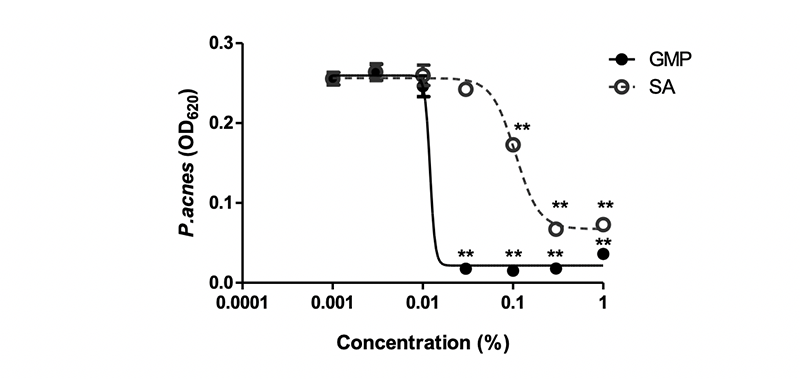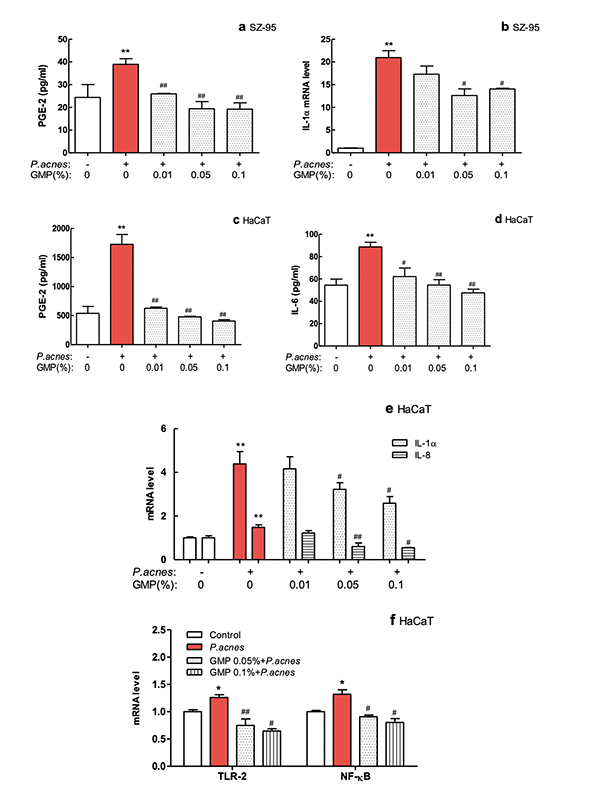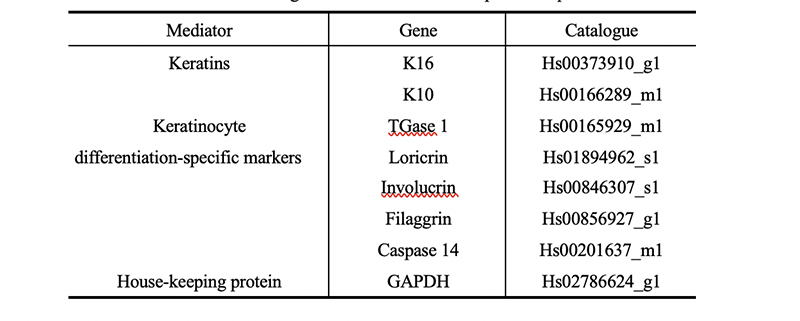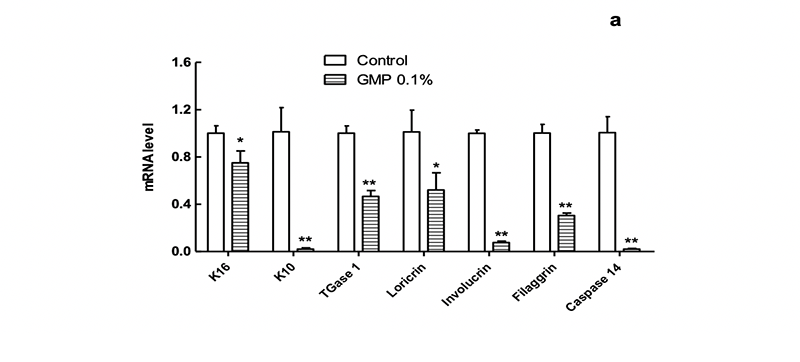Recently reports showed that the pathobiology of acne vulgaris was arising from the exploration of sebaceous gland biology, hormonal factors, hyper-keratinisation, and the role of bacteria, sebum, nutrition, cytokines and toll-like receptors (TLRs).
Propionibacterium acnes (P.acnes) has a strong proinflammatory activity and targets molecules involved in the innate cutaneous immunity on keratinocytes by acting on TLR-2, leads to the development of comedones.
GMP, a multi-herb extraction, targeted most of the major pathogenic features of acne with desired physicochemical traits. It strongly suppressed P.acnes growth, and reduced inflammation by suppressing the TLR-2/NF- kB pathway in SZ-95 sebocytes and HaCaT keratinocytes.
GMP exhibited a marginal effect on cell viability and may have modulated hyper-keratinisation of the epidermis. These results demonstrate the clinical feasibility of applying GMP for the treatment of acne.
Introduction
Acne vulgaris is a chronic inflammatory skin disease which occurs in the follicle and the sebaceous gland unit. It is mainly found in adolescents, and 80 percent of the 11~30 year old people suffer from this disease.
Increased sebum production under the inducing factors such as diet, living habits and androgens, abnormal keratinisation of keratinocytes, colonization by Propionibacterium acnes (P.acnes) and inflammation are thought to be the major pathogenic factors.
Topical antimicrobials, topical retinoids, oral antibiotics, and oral isotretinoin were used as a commonly therapy for acne, with a limited effect due to skin irradiation and antibiotic resistance [1-3].
The photodynamic therapy (PDT), a novel raw material from plants and multi-herb extractions were developed for the treatment of acne recently [3-7]. Epigallocatechin-3-gallate (EGCG) suppressed the lipogenesis, inhibited the P.acnes and inflammation to against acne.
Lupeol, a pentacyclic triterpene, identified as a therapeutic agent targeting multiple pathogenic factors of acne. We combined two highthroughput screening methods focus on anti-bacterial and anti-inflammatory to validate lots of active ingredients from different plants, and finally got a multi-herb extraction GMP which consists of the peel of Garcinia Mangostana, Magnolia Officinalis, and Punica Granatum.
In this research, we verified the effect of GMP on treatment for acne, including P.acnes suppression, anti-inflammation on human SZ-95 sebocytes and HaCaT keratinocytes, as well as beneficial effects on follicular hyperkeratosis.
Further cellular studies indicated that the modulation of TLR2/NF- kB signaling pathways mediated GMP’s anti-inflammatory effects on keratinocytes. Therefore, GMP will be used to cure acne focus on multiple pathogenic factors.
Materials and Methods
Microbial Experiments
P. acnes isolate ATCC 11827 was acquired from Beijing zhongkezhijian Biotechnology (Beijing, China). P. acnes were cultured on thioglycollate medium. The concentration was adjusted to the 0.5 McFarland turbidity and finally diluted with 100-fold in medium.
GMP was originally dissolved in PBS to the concentration of 10% and diluted to 0.01% by serial dilution. Then, 180 μl P.acnes with 20 μl samples were added into a 96-well plate, with a 48 hrs co-culture at 37℃ in anaerobic chamber.
The optical density of P.acnes growth was detected at 620 nm on a microplate reader (Multiscan FC; Thermo Fisher Scientific, USA) according to literatures [6, 8]. Results between GMP containing solution and vehicle only solution were compared and the growth inhibition at OD620 can be determined from the following equation:
Inhibition (%) = [1-OD620treatment/OD620control]×100%
For the experiments related with inflammation, P. acnes cultures were heat-killed by subjecting to temperatures of 85℃ for 30 mins [5, 6].
Cell Culture and Stimulation
The SZ-95 immortalized human sebocyte cell line and the human keratinocyte cell line HaCaT were cultured and maintained in DMEM mediumsupplemented with 10% fetal bovine serum and 1% antibiotic/antimycotic solution (5000 U/ml penicillin and 5 mg/ml streptomycin; Invitrogen, CA) at 37 ℃ in a 5% CO2 incubator as described [4-6].
For stimulation experiments, SZ-95 and HaCaT cells were incubated with the heat-killed P. acnes suspension adjusted at the appropriate concentration in culture medium for the desired period of time at 37 ℃ in 5% CO2 [5, 6].
Cell Viability Test
Measurements were performed as described in literatures [9]. In brief, SZ-95 and HaCaT cells were seeded in a 96-well plate at a density of 2 or 1×104 cells per well. And then cells were treated with GMP (1% to 0.06% by serial dilution), with or without P. acnes stimulation. Medium alone was used as a control.
After 24 hrs treatment, 0.5 mg/ml of 3-(4, 5-dimethylthiazol-2-yl)-2, 5- diphenyl -tetrazolium bromide (MTT; Sigma, MO) was introduced into each well and incubated for another 4 hrs at 37℃.
The converted dye was solubilised with DMSO. The optical density of the wells was determined using the Multiscan FC (Thermo Fisher Scientific, USA) at 492 nm. The cell viability at OD492 can be determined from the following equation:
Viability (%) = OD492treatment/OD492control×100%
mRNA Expression Measurement in HaCaT Cells
HaCaT cells were seeded in 6-well plates at a density of 3×105 per well. After 24 hrs of GMP treatments on HaCaT cell culture, total RNA was extracted by PureLink Mini Kit (Invitrogen, CA), and the concentration was determined by measuring the A260 of the samples.
The first-strand cDNA was synthesised from 0.5 μg RNA and real-time polymerase chain reactions (PCRs) were performed according to manuals from the TaqMan RNA-to-CT Kits (Invitrogen, CA).
Primer sequences of keratin 16 and 10, loricrin, involucrin, transglutaminase 1, filaggrin and caspase-14 were recorded according to manufacturers’ manual of TaqMan Probe/ROX q-PCR kit (TaqMan Applied Biosystems, NJ) [10-12]. Real-time PCR were conducted in an ABI 7500 system (Invitrogen, CA) accompanied with CT values.
For the experiment of HaCaT keratinocytes stimulated with heat inactivated P. acnes, primers for interleukin (IL) -1α, toll-like receptor 2 (TLR-2) and nuclear factor kappa-B (NF-κB) were also used [13].
The mRNA level of each sample for each gene was normalized to that of the glyceraldehyde 3-phosphate dehydrogenase (GAPDH) mRNA in all experiments. The relative fold change was quantificated by 2-ΔΔCT method compared with untreated controls from the following equation:
ΔΔCT = (CTtarget gene-CTGAPDH) treatment - (CTtarget gene-CTGAPDH) control
mRNA Expression Measurement in SZ-95 Cells
SZ-95 cells were seeded in 6-well plates at a density of 6×105 per well, and then stimulated with heat inactivated P. acnes and GMP for 24 hrs. The mRNA level of IL-1α was determined as mentioned above.
ELISA Experiments
SZ-95 and HaCaT cells co-cultured with P. acnes for 24 hrs were treated with control and GMP (0.1% to 0.01% by serial dilution) similar with mRNA expression assay. Prostaglandin E2 (PGE-2) and IL-6 protein in the supernatants of SZ-95 and HaCaT cells were determined with the corresponding ELISA kit (Neobioscience, China) according to the manufacturers’ instructions [14, 15]. The concentration of PGE-2 and IL-6 was calculated by standard curves reading at OD450.
Statistical Analysis
All experiments were repeated at least three times with different batches of cells. Data were evaluated statistically using Student’s t-test. Statistical significance was set at P<0.05.
Results
GMP inhibits the growth of P. acnes
To compare dose-response effects of GMP and salicylic acid (SA) on the growth of bacteria that is present in the acne vulgaris, P.acnes were co-cultured with either agent at various concentrations for 48 hrs.
Bacterial growth was evaluated by measuring absorbance at 620 nm (Figure 1). Both GMP and SA were tested at concentrations of serial dilutions from 1% to 0.001%.
We found that when GMP concentration is higher than 0.03%, it killed almost the whole P. acnes. In contrast, no killing was observed when GMP is at 0.01%. Therefore, we estimated the minimal inhibitory concentration (MIC), the lowest concentration to prevent bacterial growth of GMP against P. acnes (ATCC 11827) was 0.03%. The MIC of SA was 0.3% meanwhile. This suggests that GMP has much stronger antimicrobial activity than SA.

Figure 1. Bactericidal effects of GMP on P. acnes.
P. acnes (1×106 CFU per ml) were incubated with 0.001-1% of GMP (solid circles) and SA (open circles) in medium for 48 hrs under anaerobic conditions at 37℃. After incubation, OD620 of each sample was measured by a microplate reader to determine bacterial growth. Data represent mean±SD of three individual experiments (**P<0.01 by Student’s t-test vs. control).
GMP promoted the viability of HaCaT cells when stimulated with P.acnes
Human sebocyte and keratinocyte are the major target cells of P. acnes in acne patients [16, 17]. So cytotoxicity of P.acnes and GMP was examined on SZ-95 and HaCaT cells.
Firstly, the two cell lines were incubated with GMP at various concentrations from 0.06-1% for 24 hrs at 37℃ and MTT assay was used to detect the viability subsequently (Tabel 1). It was found that GMP did not affect sebocyte and keratinocyte viability at the high concentration of 0.125%, at which P. acnes was completely killed as shown in Figure 1. And interesting, in HaCaT cells, GMP promoted the cell viability to 121.8% under 0.125% concentration, indicated that GMP may be stimulating the activity of mitochondri to regulate epidermal renewal.

Table 1. Effect of GMP on the viability of cells
The SZ-95 (2×104 cells) and HaCaT (1×104 cells) were cocultured with 0.06-1% of GMP for 24 hrs at 37℃. After incubation, cell viability was determined by MTT assay. Data represent mean±SD of three individual experiments (**P<0.01 by Student’s t-test vs. control).
Then, the cytotoxicity of P.acnes was tested in these two cells. Results demonstrated that P.acnes affected the cell proliferation in HaCaT cells (Table 2) but showed little influence in SZ-95 cells (data not shown).
The viability of HaCaT cells was decreased to 72.2% when co-cultured with P.acnes, and GMP recovered the viability to 108.0% under 0.1% concentration compared with control. This data indicated that GMP can reject the P.acnes’ effect on cell proliferation to against acne.

Table 2. Effect of GMP on the viability of HaCaT cells after P.acnes stimulation
The HaCaT (1×104 cells) were cocultured with 0.03-1% of GMP and heat-killed P.acnes for 24 hrs at 37℃. After incubation, cell viability was determined by MTT assay. Data represent mean±SD of three individual experiments (**P<0.01 by Student’s t-test vs. control; ##P<0.01 by Student’s t-test vs. P.acnes).
GMP decreases inflammation induced by P. acnes through the TLR-2 and NF-κB
P. acnes colonization of the follicule is another critical pathological factor for acne, which increases the inflammatory response mainly through the TLR-2 and NF-κB pathways [18, 19].
Heat-inactivated P. acnes were recognized by human innate immune system, to induce several molecular markers of inflammation, including IL-1α, IL-1 β, tumor necrosis factor (TNF) - α, IL-6, IL-12, PGE-2 and IL-8, in sebocytes, keratinocytes and macrophages [18-20]. We investigated anti-inflammatory effects of GMP in SZ-95 sebocytes (Figure 2a-b) and HaCaT keratinocytes (Figure 2c-e), two major cutaneous target cells of acne by ELISA and real-time PCR analysis.
Results indicated P.acnes stimulated inflammation by up-regulating the expression of cytokines, such as PGE-2, IL-6, IL-1α and IL-8. When co-cultured with GMP (0.01-0.1%) and P.acnes, the secretion of PGE-2 and IL-6 in cells was significantly inhibited, and the mRNA level of IL-1α and IL-8 was also down-regulated, strongly supporting its anti-inflammatory effect.
To further investigate the underlying molecular mechanisms, we checked the activation of NF-κB transcription factor and the mRNA level of TLR-2 responsible for regulation of the inflammatory response (Figure 2f) in HaCaT cells.
We found that the mRNA expressions of NF- kB p65 and TLR-2 were increased after P.acnes treatment, suggesting the activation of inflammation, while GMP significantly down-regulated the mRNA levels under 0.05% to 0.1% concentrations for HaCaT keratinocytes. It’s confirming that GMP inhibited innate immunity of two major cutaneous cells associated with inflammatory acne by down-regulating the TLR-2 receptor and mitigating the NF- kB pathway stimulated by heat-inactivated P. acnes (Figure 2a-f).

Figure 2. GMP decreases inflammation induced by P. acnes through the inhibition of TLR-2 and NF-κB. (a-f) SZ-95 and HaCaT cells stimulated with P. acnes were treated with GMP (0.01%-0.1%) for 24 hours. ELISA for PGE-2 protein (a) in the supernatant and real-time PCR for IL-1α (b) mRNA level in the cultured SZ-95 cells were performed after treatment.
ELISA for PGE-2 (c) and IL-6 (d) proteins in the supernatant, real-time PCR for IL-1α and IL-8 (e) mRNA levels in the cultured HaCaT cells were performed after treatment. Then, the TLR-2 and NF-κB mRNA (f) expression in HaCaT cells were also detected using the real-time PCR method. Data represent mean±SD of three individual experiments (**P<0.01,*P<0.05 by Student’s t-test vs. control; ##P<0.01,#P<0.05 by Student’s t-test vs. P.acnes).
GMP inhibited the mRNA expression levels related to hyper keratinisation
Because follicular epidermal dyskeratosis is another major triggering factor of acne pathogenesis, and GMP down-regulated the IL-1α mRNA expression which has been reported to induce hyper keratinization in follicular infundibulum in vitro and in vivo [21], we investigated the possible beneficial effects of GMP on other genes related to terminal differentiation of epidermal keratinocytes, including keratins K16, K10, transglutaminases TGase 1, loricrin, involucrin, filaggrin and caspase 14 [22, 23] (Table 3).

Table 3. The catalogue of sense and antisense primer sequences
It was found that GMP significantly down-regulated all the genes listed above especially for K10, involucrin and caspase 14 (below to 0.1), showed an inhibited effect on keratinocyte differentiations (Figure 3a).


Figure 3. GMP decreases the mRNA expression related to keratinocyte differentiation on HaCaT cells.
HaCaT (1×104 cells) were cocultured with 0.1% of GMP and P.acnes for 24 hrs at 37℃. After incubation, total RNA was extracted to detect the expression level of genes by qRT-PCR. (a) Seven genes were influenced by GMP only. (b) Five genes were regulated by GMP after P.acnes stimulation. Data represent mean±SD of three individual experiments (**P<0.01,*P<0.05 by Student’s t-test vs. control; ##P<0.01,#P<0.05 by Student’s t-test vs. P.acnes ).
P. acnes modulate the expression of genes coding keratinocyte proteins implicated in the terminal differentiation of the epidermis, such as transglutaminases, involucrin and filaggrin in a strain dependent manner [22]. We confirmed this result, and also found P.acnes induced the mRNA expression of K16 and caspase 14 (Figure 3b), leading to hyper keratinization in follicular infundibulum.
Subsequently, we detected GMP’s effect on these five genes after P.acnes stimulated and results demonstrated GMP down-regulated the mRNA expression of K16, TGase 1, involucrin, filaggrin and caspase 14 (Figure 3b) which remarkably increased by P.acnes, to suppress hyper-keratinization in acne. A schematic diagram of GMP’s therapeutic mechanisms based on whole experimental results is illustrated in Figure 4.

Figure 4. Possible therapeutic mechanisms based on our in vitro results. These mechanisms could elucidate the efficacy of GMP in the treatment of acne
Discussion
P. acnes, a Gram-positive anaerobic bacterium, is a commensal of human skin, and its overgrowth is closely implicated in the progression of inflammation in acne. Until recently, various antibiotics have been used to control the overgrowth of P. acnes, yet increasing antibiotic resistance and biofilm formation lead to a poor outcome.
An accumulating body of evidence suggests that lots of natural active ingredient from plant extracts shows antimicrobial activity against a diverse range of microorganisms, including bacteria, viruses, and fungi. Indeed, we found that GMP, a multi-herb extraction of Garcinia Mangostana, Magnolia Officinalis, and Punica Granatum, significantly inhibits the growth of P. acnes. This antibiotic effect of GMP may provide an advantage as a therapeutic strategy for the treatment of acne, especially considering increasing concerns about antibiotic-resistant bacteria.
Many human diseases are often associated with a chronic inflammatory response, which also has a critical role in the development of acne. We found that GMP suppresses the inflammatory response induced by heat-inactivated P. acnes in SZ-95 sebocytes and HaCaT keratinocytes, two major well-established in vitro models of inflammatory acne, through the inhibition of TLR-2 and NF- kB pathways.
It is also remarkable that GMP decreases IL-1α in HaCaT and SZ-95 cells, based on the fact that IL-1α induces hypercornification of the infundibulum in a manner similar to that seen in comedones. These results suggest that GMP might reverse the altered keratinization of follicular keratinocytes through the regulation of IL-1α.
Anomalies in the infra-infundibulum of proliferation, adhesion and differentiation of keratinocytes lead to the formation of a micro-comedo. The differentiation of keratinocytes also occurs in healthy skin, namely the formation of the cornified cell envelope (CE). This reaction is controlled by various factors.
In this study, we investigated the influence of keratin K10 and K16, CE related proteins such as involucrin, TGase-1, loricrin, filaggrin and caspase 14, which are the main component proteins of keratinocyte differentiation. On the other hand, there have been reports demonstrated that filaggrin expression was increased in acne lesions.
GMP significantly decreased the mRNA expression of keratins and CE proteins in its own and in heat-inactivated P. acnes stimulated manner. Together, these data provide insight to the molecular basis of the therapeutic effects of GMP on the inflammatory acne lesions in a clinical trial.
In summary, GMP modulated the key pathological factors contributing to acne, including P.acnes overgrowth, inflammation and hyper keratinisation in follicular infundibulum. These results strongly suggest the potential clinical feasibility of GMP in acne treatment.
References
1. I Kurokawa, FW Danby, Q Ju, et al. New developments in our understanding of acne pathogenesis and treatment[J]. Experi mental Dermatology, 2009, 18 (10): 821-832
2. A Charakida, M Charakida, AC Chu. Double-blind, randomized, placebo-controlled study of a lotion containing triethyl citrate and ethyl linoleate in the treatment of acne vulgaris[J]. British Journal of Dermatology, 2007, 157 (3): 569-574
3. YH Sun, JI Na, CH Huh and KC Park. The Effect of Photodynamic Therapy Using Indole-3-Acetic Acid and Green Light on Acne Vulgaris[J]. Annals of Dermatology, 2012, 24(1): 56-60
4. M Im, SY Kim, KC Sohn, et.al. Epigallocatechin-3-Gallate Suppresses IGF-I-Induced Lipogenesis and Cytokine Expression in SZ95 Sebocytes[J]. Journal of Investigative Dermatology, 2012, 132 (12): 2700-2708
5. YY Ji, HH Kwon, SU Min, et.al. Epigallocatechin-3-Gallate Improves Acne in Humans by Modulating Intracellular Molecular Targets and Inhibiting P. acnes[J]. Journal of Investigative Dermatology, 2013, 133 (2): 429-440
6. HH Kwon, JY Yoon, SY Park, et.al. Activity-guided purification identifies lupeol, a pentacyclic triterpene, as a therapeutic agent multiple pathogenic factors of acne[J]. Journal of Investigative Dermatology, 2015, 135 (6): 1491-1500
7. KI Kim, HJ Nam, M Kim, et.al. Effects of herbal medicine for dysmenorrhea treatment on accompanied acne vulgaris: a study protocol for a randomized controlled trial[J]. Bmc Complementary & Alternative Medicine, 2017, 17 (1): 318-325
8. CH Liu, HY Huang. In vitro anti-propionibacterium activity by curcumin containing vesicle system[J]. Chemical & Pharmaceutical Bulletin, 2013, 61 (4): 419-425
9. EG Lim, GT Kim, MK Bo, et al. Study of Anti-microbial Activities and Anti-inflammatory Effects of Chamomile (Matricaria chamomilla) Extracts in HaCaT cells[J]. JKsbb Journal, 2017, 32 (1): 9-15
10 YN Lu, YD Yang, ZY Xie. Promoting effect of Gmoist Sea-Gel on skin hydration and barrier function[J]. China Surfactant Detergent & Cosmetics, 2017, 47 (12): 709-712. Chinese
11. S Gretherbeck, I Felsner, H Brenden, et al. Urea uptake enhances barrier function and antimicrobial defense in humans by regulating epidermal gene expression[J]. Journal of Investigative Dermatology, 2012, 132 (6): 1561-1572
12. B Skiba, B Neill, TJ Piva. Gene expression profiles of TNF-α, TACE, furin, IL-1β and matrilysin in UVA- and UVB-irradiated HaCat cells[J]. Photodermatology Photoimmunology & Photomedicine, 2005, 21 (4): 173
13. TH Tsai, LT Chuang, TJ Lien, et al. Rosmarinus officinalis extract suppresses Propionibacterium acnes-induced inflammatory responses[J]. Journal of Medicinal Food, 2013, 16 (4): 324
14. M Fritz, AM Klawonn, A Nilsson, et al. Prostaglandin-dependent modulation of dopaminergic neurotransmission elicits inflammation-induced aversion in mice[J]. Journal of Clinical Investigation, 2016, 126 (2): 695-705
15. M Zeng, ZY Li, J Ma, et al. Clarithromycin and dexamethasone show similar anti-inflammatory effects on distinct phenotypic chronic rhinosinusitis: an explant model study[J]. BMC immunology, 2015, 16 (1):37
16. C Beylot, N Auffret, F Poli, et al. Propionibacterium acnes: an update on its role in the pathogenesis of acne [J]. Journal of the European Academy of Dermatology & Venereology, 2013, 28 (3): 271-278
17. U Jappe. Pathological mechanisms of acne with special emphasis on Propionibacterium acnes and related therapy [J]. Acta Derm Venereol, 2003, 83 (4): 241-248
18. BR Vowels, S Yang, JJ Leyden. Induction of proinflammatory cytokines by a soluble factor of Propionibacterium acnes: implications for chronic inflammatory acne [J]. Infection and Immunity, 1995, 63 (8): 3158-3165
19. GW Agak, M Qin, J Nobe, et al. Propionibacterium acnes Induces an IL-17 Response in Acne Vulgaris that Is Regulated by Vitamin A and Vitamin D[J]. Journal of Investigative Dermatology, 2014, 134 (2): 366
20. HH Tsai, WR Lee, PH Wang, et al. Propionibacterium acnes-induced iNOS and COX-2 protein expression via ROS-dependent NF-kappa B and AP-1 activation in macrophages[J]. Journal of Dermatological Science, 2012, 69 (2): 122-131
21. JL Selway, T Kurczab, T Kealey and K Langlands. Toll-like receptor 2 activation and comedogenesis: implications for the pathogenesis of acne[J]. BMC Dermatology, 2013, 13 (1): 1-7
22. N Akaza, H Akamatsu, M Kishi, et al. Effects of Propionibacterium acnes on various mRNA expression levels in normal human epidermal keratinocytes in vitro[J]. Journal of Dermatology, 2009, 36 (4): 213-223
23. E Candi, R Schmidt, G Melino. The cornified envelope: a model of cell death in the skin[J]. Results & Problems in Cell Differentiation, 1998, 24 (4): 175.
